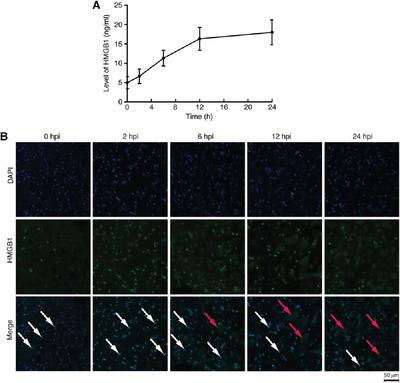当前位置:
X-MOL 学术
›
J. Leukoc. Biol.
›
论文详情
Our official English website, www.x-mol.net, welcomes your
feedback! (Note: you will need to create a separate account there.)
High mobility group box-1 serves a pathogenic role in spinal cord injury via the promotion of pro-inflammatory cytokines
Journal of Leukocyte Biology ( IF 3.6 ) Pub Date : 2021-08-17 , DOI: 10.1002/jlb.3ma0721-007r Ke-Bing Chen 1 , Min-Min Chang 2 , Sheng-Li Wang 3, 4 , Yong-Xin Li 5 , Yi-Xi Wang 6 , Zhi-Guang Xu 1 , Hong Wang 7 , Bing-Cheng Zhao 8 , Wei-Ying Ma 9
Journal of Leukocyte Biology ( IF 3.6 ) Pub Date : 2021-08-17 , DOI: 10.1002/jlb.3ma0721-007r Ke-Bing Chen 1 , Min-Min Chang 2 , Sheng-Li Wang 3, 4 , Yong-Xin Li 5 , Yi-Xi Wang 6 , Zhi-Guang Xu 1 , Hong Wang 7 , Bing-Cheng Zhao 8 , Wei-Ying Ma 9
Affiliation

|
Traumatic spinal cord injury (SCI) is a devastating condition marked by permanent motor, sensory, and autonomic dysfunction, in which the inflammatory response serves an important and preventable role. High mobility group box-1 (HMGB1) is a potent regulator of inflammation in numerous acute and chronic inflammatory conditions.; however, the role of HMGB1 in SCI remains unclear. The present study aimed to characterize the temporal dynamics of HMGB1 release after SCI, to investigate the role of spinal microglia activation in mediating the effects of HMGB1 on SCI, and to explore the therapeutic potential of intrathecal anti-HMGB1 polyclonal antibody on alleviating SCI. The present study demonstrated that HMGB1 expression was increased immediately after traumatic injury of a primary spinal neuron culture. It was found that neutralizing HMGB1 significantly ameliorated SCI pathogenesis and hind limb paralysis. Moreover, the levels of a number of pro-inflammatory cytokines in the SCI lesion were reduced when local HMGB1 was blocked by anti-HMGB1 antibody. In addition, the injured neuron-derived conditioned medium increased TNF-α secretion and the NF-κB pathway in the BV2 microglia cell line via HMGB1. Collectively, these results indicated that HMGB1 served an important role in SCI inflammation and suggested the therapeutic potential of an anti-HMGB1 antibody for SCI.
中文翻译:

高迁移率族 box-1 通过促进促炎细胞因子在脊髓损伤中发挥致病作用
创伤性脊髓损伤 (SCI) 是一种破坏性疾病,其特征是永久性运动、感觉和自主神经功能障碍,其中炎症反应起着重要且可预防的作用。高迁移率族框 1 (HMGB1) 是许多急性和慢性炎症条件下炎症的有效调节剂。然而,HMGB1 在 SCI 中的作用仍不清楚。本研究旨在表征 SCI 后 HMGB1 释放的时间动态,研究脊髓小胶质细胞激活在介导 HMGB1 对 SCI 的影响中的作用,并探讨鞘内抗 HMGB1 多克隆抗体对缓解 SCI 的治疗潜力。本研究表明 HMGB1 表达在原代脊髓神经元培养的外伤性损伤后立即增加。发现中和 HMGB1 显着改善了 SCI 发病机制和后肢麻痹。此外,当局部 HMGB1 被抗 HMGB1 抗体阻断时,SCI 病变中许多促炎细胞因子的水平降低。此外,受损的神经元衍生条件培养基通过 HMGB1 增加了 BV2 小胶质细胞系中 TNF-α 的分泌和 NF-κB 通路。总的来说,这些结果表明 HMGB1 在 SCI 炎症中发挥重要作用,并表明抗 HMGB1 抗体对 SCI 的治疗潜力。受损的神经元衍生条件培养基通过 HMGB1 增加了 BV2 小胶质细胞系中 TNF-α 的分泌和 NF-κB 通路。总的来说,这些结果表明 HMGB1 在 SCI 炎症中发挥重要作用,并表明抗 HMGB1 抗体对 SCI 的治疗潜力。受损的神经元衍生条件培养基通过 HMGB1 增加了 BV2 小胶质细胞系中 TNF-α 的分泌和 NF-κB 通路。总的来说,这些结果表明 HMGB1 在 SCI 炎症中发挥重要作用,并表明抗 HMGB1 抗体对 SCI 的治疗潜力。
更新日期:2021-08-17
中文翻译:

高迁移率族 box-1 通过促进促炎细胞因子在脊髓损伤中发挥致病作用
创伤性脊髓损伤 (SCI) 是一种破坏性疾病,其特征是永久性运动、感觉和自主神经功能障碍,其中炎症反应起着重要且可预防的作用。高迁移率族框 1 (HMGB1) 是许多急性和慢性炎症条件下炎症的有效调节剂。然而,HMGB1 在 SCI 中的作用仍不清楚。本研究旨在表征 SCI 后 HMGB1 释放的时间动态,研究脊髓小胶质细胞激活在介导 HMGB1 对 SCI 的影响中的作用,并探讨鞘内抗 HMGB1 多克隆抗体对缓解 SCI 的治疗潜力。本研究表明 HMGB1 表达在原代脊髓神经元培养的外伤性损伤后立即增加。发现中和 HMGB1 显着改善了 SCI 发病机制和后肢麻痹。此外,当局部 HMGB1 被抗 HMGB1 抗体阻断时,SCI 病变中许多促炎细胞因子的水平降低。此外,受损的神经元衍生条件培养基通过 HMGB1 增加了 BV2 小胶质细胞系中 TNF-α 的分泌和 NF-κB 通路。总的来说,这些结果表明 HMGB1 在 SCI 炎症中发挥重要作用,并表明抗 HMGB1 抗体对 SCI 的治疗潜力。受损的神经元衍生条件培养基通过 HMGB1 增加了 BV2 小胶质细胞系中 TNF-α 的分泌和 NF-κB 通路。总的来说,这些结果表明 HMGB1 在 SCI 炎症中发挥重要作用,并表明抗 HMGB1 抗体对 SCI 的治疗潜力。受损的神经元衍生条件培养基通过 HMGB1 增加了 BV2 小胶质细胞系中 TNF-α 的分泌和 NF-κB 通路。总的来说,这些结果表明 HMGB1 在 SCI 炎症中发挥重要作用,并表明抗 HMGB1 抗体对 SCI 的治疗潜力。











































 京公网安备 11010802027423号
京公网安备 11010802027423号